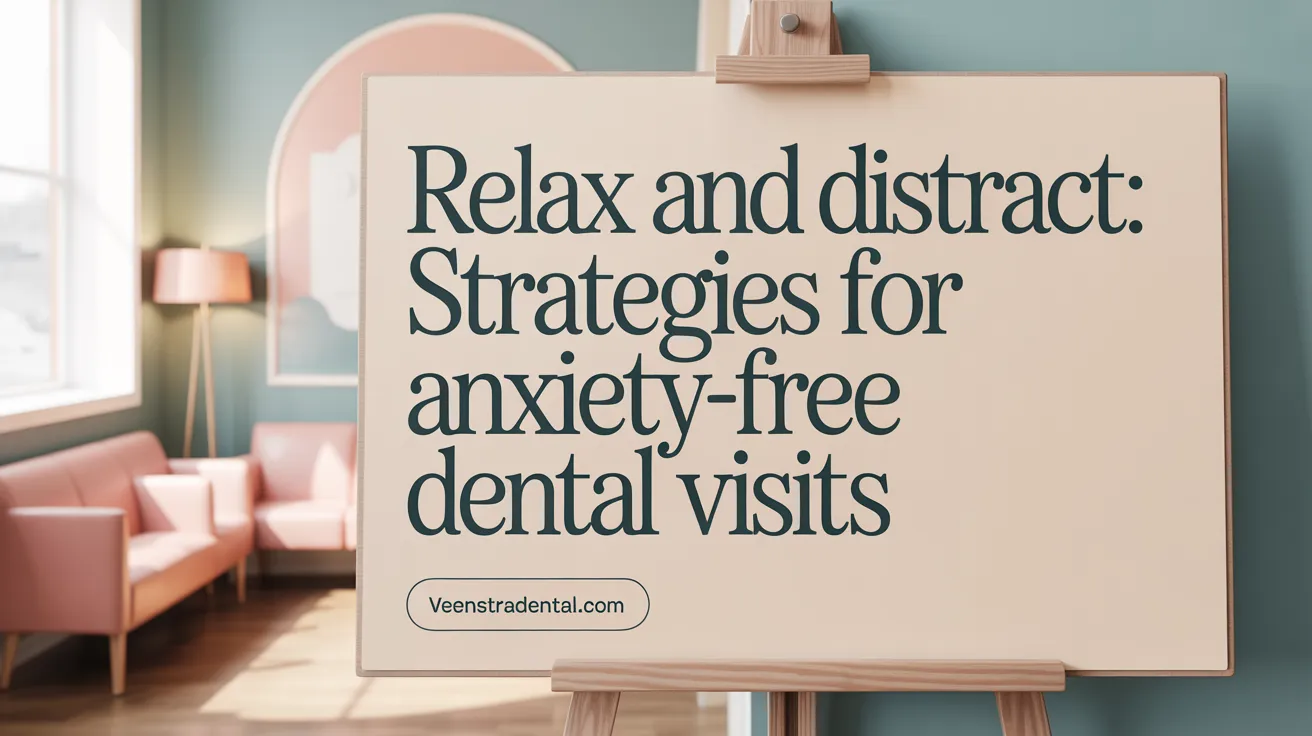Understanding Dental Anxiety and Its Impact
Dental anxiety is a common issue that affects patients of all ages and can significantly hinder access to essential dental care. Recognizing its causes and effects is vital to creating a comfortable dental care experience. Anxiety can stem from past traumatic experiences, fear of pain, or a perceived loss of control during treatment, often leading to avoidance that worsens oral health. Understanding these factors is the first step toward effective management and ensuring patients receive the care they need in a compassionate environment.
Recognizing and Managing Dental Anxiety
What causes dental anxiety and what are its signs?
Dental anxiety commonly arises from past traumatic experiences with dental care, physical trauma to the head or neck, underlying mental health disorders such as anxiety disorders, and fears related to loss of control or invasive dental procedures. Typical signs of dental anxiety include physical symptoms like sweating, a racing heartbeat, fainting, visible distress, and withdrawal behaviors. Sometimes, individuals may use humor or display aggression as a way to mask their fear. For detailed information on Dental anxiety causes and Signs of dental anxiety, refer to this resource.
How does dental anxiety affect oral health?
Avoiding dental visits due to anxiety can result in the progression of oral health problems, leading to more severe dental diseases. This avoidance creates a vicious cycle where unaddressed issues require increasingly complex and invasive treatments. Furthermore, delaying regular check-ups can prevent early detection of conditions such as cavities, gum disease, and mouth cancer, adversely affecting overall health. Learn more about the Effects of avoiding dental visits and the Importance of regular dental check-ups.
What techniques help manage dental anxiety psychologically and behaviorally?
Management strategies include relaxation techniques for dental anxiety, such as deep breathing exercises, guided imagery, muscle relaxation, and distraction methods like listening to music. Psychological interventions, particularly cognitive-behavioral therapy (CBT) in dental anxiety, have proven effective in treating dental anxiety and phobia. Establishing clear communication, including the use of hand signals during treatments, empowers patients to express discomfort or request pauses, enhancing their sense of control. For more on relaxation, CBT, and patient communication, see these resources.
How are patients with dental anxiety assessed in clinical settings?
Dental professionals utilize tools like interviews and standardized questionnaires, including Corah’s Dental Anxiety Scale and the Modified Dental Anxiety Scale, to identify anxiety levels. Objective physiological measures such as monitoring blood pressure and galvanic skin responses can also help gauge patient distress. These assessments allow for tailored anxiety management plans combining behavioral, psychological, and pharmacological approaches to meet individual needs. For more details on clinical standards for dental anxiety management and anxiety management techniques in primary dental care, check the following references.
Creating a Welcoming and Soothing Dental Environment

How can the dental office environment reduce patient anxiety?
Creating a calming dental environment is crucial for reducing patient anxiety. This can be achieved by incorporating soothing elements such as gentle music and aromatherapy to create a serene atmosphere. Comfortable, ergonomic dental chairs and warm blankets add physical comfort, while calming colors and friendly decor help to establish a welcoming space. Such an environment builds trust and makes patients feel more at ease during visits (Comfort Items for Dental Anxiety, Calming dental decor, Soothing techniques with calming music and aromatherapy).
What technological advancements aid in patient comfort?
Advances in dental technology play a significant role in enhancing patient comfort. Laser dentistry minimizes pain and reduces recovery time, while needle-free anesthetics lessen the discomfort associated with injections. Digital imaging and computer-controlled local anesthetic delivery systems allow for more precise and less invasive treatments. Ergonomic equipment further boosts physical comfort, all contributing to a less stressful dental experience, especially for anxious patients (Modern dental anesthesia technology, Advanced dental technology.
Why is staff training important in managing dental anxiety?
Staff training is vital in managing dental anxiety effectively. Teams trained in empathy, active listening, and clear communication can build strong rapport with patients (Improving dentist-patient communication, Empathy Training for Dental Staff). This encourages patients to openly discuss their fears and concerns, allowing care to be personalized to their needs. Such patient-centered communication helps reduce anxiety, making treatment more comfortable and less intimidating (Patient Communication at Beaver Dental, Effective Communication in Dental Anxiety Management).
Effective Communication and Patient Education
How does communication improve the dental experience?
Open and empathetic communication is foundational to a positive dental experience. When dental professionals engage in open dialogue about fears and treatment steps, patients feel heard and respected. This trust-building reduces anxiety, as patients understand what to expect and can express their concerns. Tailoring strategies to individual needs becomes possible through this communication, ensuring personalized care for anxious patients. For more on improving dentist-patient communication, see Improving dentist-patient communication and Effective dental communication.
What educational tools assist in reducing anxiety?
Educational tools play a vital role in easing dental anxiety. Dentists use simple language free from technical jargon alongside visual aids such as images or diagrams to explain procedures clearly. Additionally, offering office tours before treatment familiarizes patients with the environment, helping them feel more at ease and reducing the fear of the unknown. Learn more about Patient education on dental procedures, Dental office tours, and Familiarization with dental office.
How does patient engagement affect treatment?
Encouraging patients to ask questions and provide feedback promotes active participation in their dental care. This empowerment leads to better adherence to treatment plans, as patients understand the rationale behind procedures and feel involved in decisions about their oral health. For details, see Importance of patient feedback and Patient feedback on dental experience.
Importance of office tours and familiarization
Pre-visit office tours allow patients, especially those with anxiety, to explore the space in a low-pressure setting. Familiarity with the clinic, dental staff, and equipment diminishes anxiety triggers and creates a welcoming atmosphere. This proactive approach fosters comfort and confidence ahead of dental visits. Explore more about Familiarization with dental office and Dental office tours to ease anxiety.
Personalized Anxiety Management and Sedation Options
How are anxiety levels assessed and managed in dental care?
Dentists assess dental anxiety through a combination of patient interviews, standardized anxiety questionnaires such as the Modified Dental Anxiety Scale (MDAS), and physiological signs like blood pressure and skin responses. This comprehensive evaluation helps determine the severity of anxiety and guides the dental team in tailoring individualized management plans. Behavioral therapies, such as relaxation techniques for dental anxiety, deep breathing, guided imagery, and cognitive-behavioral therapy (CBT) in dental anxiety, are commonly used. When psychological interventions alone are insufficient, pharmacological treatments, including sedation, may be integrated.
What sedation options are available for anxious patients?
Sedation dentistry options provide varied choices to suit different levels of anxiety. For mild anxiety, nitrous oxide sedation, or "laughing gas," offers safe minimal sedation causing relaxation while keeping the patient conscious. Oral sedatives for dental care are administered for moderate sedation to ease fears and promote drowsiness. In more severe anxiety or for extensive procedures, IV sedation services or general anesthesia may be recommended. These are administered by trained professionals under strict safety standards to ensure patient comfort and well-being.
How do dentists empower anxious patients during treatment?
Empowering patients is crucial for managing anxiety. Dentists establish effective communication with dental patients to discuss fears and procedures clearly, building trust. They often implement signals to manage fear during dental procedures—allowing patients to request a pause at any point—enhancing patient control. Regular breaks during longer appointments provide additional comfort and reassurance. This partnership approach helps nervous patients feel secure, supported, and actively involved in their care journey.
The combination of thorough anxiety assessment, personalized psychological and pharmacological interventions, and patient-centered communication forms the foundation of effective managing dental anxiety.
Relaxation Techniques and Distraction Strategies

What behavioral techniques help reduce anxiety during dental visits?
Behavioral methods such as deep diaphragmatic breathing, progressive muscle relaxation, and guided imagery are effective in calming dental anxiety. These techniques activate the body's parasympathetic nervous system, which helps slow the heart rate and ease tension. Mindfulness practices also assist patients by redirecting attention away from stress and fostering a sense of calm and control.
How do distraction methods aid anxious patients?
Distraction techniques play a crucial role in managing dental anxiety. Patients often find relief by listening to music or watching videos during procedures, which diverts their focus from the dental environment. The use of noise-canceling headphones enhances this effect by blocking ambient sounds like drilling or conversation, making the experience less intimidating.
What role do comfort items and support persons play?
Allowing patients to hold comfort objects, such as stress balls or blankets, provides tactile reassurance during treatments. Additionally, having a trusted companion accompany the patient offers emotional support and reassurance, further promoting relaxation and reducing feelings of vulnerability in the dental setting.
Incorporating these relaxation techniques for dental anxiety and distraction strategies enhances the overall dental experience, making visits more tolerable and helping patients maintain regular oral health care.
Promoting Preventive Care and Positive Dental Experiences

How does good oral hygiene relate to dental anxiety?
Maintaining good oral hygiene is crucial not only for dental health but also for reducing dental anxiety related to dental visits. Daily practices such as brushing twice with fluoride toothpaste, flossing once a day, and using antimicrobial mouthwash decrease the likelihood of cavities and gum disease. As a result, this reduces the need for invasive treatments that often trigger dental anxiety. When patients require fewer complex procedures, their fear and avoidance diminish, creating a healthier cycle of oral care.
What strategies help children overcome dental fear?
Supporting children in overcoming dental fear is essential for developing lifelong positive dental habits. Dental practices can create a child-friendly dental office with bright colors, themed decorations, and child-sized furniture to make visits more inviting. Gentle, trained pediatric staff who use positive reinforcement and distraction tools like toys or cartoons help shift the child's focus away from dental instruments. Preparing children before visits and employing reward systems further encourage trust and comfort.
Why is fostering positive dental experiences important?
Positive dental experiences build patient confidence and reduce the likelihood of avoidance due to fear. When patients feel comfortable and supported, they are more motivated to attend regular check-ups and maintain their oral health. This proactive approach enables early detection of dental diseases and prevents more complex problems down the line, enhancing overall well-being. Creating a comfortable dental environment is key to fostering trust and patient satisfaction.
How does feedback and continuous improvement enhance dental care?
Encouraging patient feedback helps dental teams tailor their approach to individual needs and continuously improve the quality of care. Open communication and a commitment to compassionate, patient-centered treatment foster trust and make patients feel valued. Incorporating patient suggestions can lead to innovations in comfort and anxiety management, contributing to better dental experiences for all.
Integrating Compassion and Technology for Anxiety-Free Dentistry
Creating a comfortable dental care experience for anxious patients requires a comprehensive strategy that includes understanding anxiety causes, fostering open communication, personalizing treatment approaches, and utilizing modern technology and sedation when necessary. Emphasizing relaxation techniques, building a soothing environment, and supporting patients emotionally build trust and empower them to maintain regular dental care. With compassionate care teams and ongoing advancements in dental practices, overcoming dental anxiety is an achievable goal that improves patients' oral and overall health long term.
